~ * ~
This article is written by Katja Blum
Papier mâché (French for “chewed paper) is a sculptural technique that most people know from elementary school, Mardi Gras floats and big rocks falling on Captain Kirk. But did you know that papier mâché was used for making coffins in Ancient Egypt, for armor, medieval church and castle interiors, boats and even aircraft fuel tanks during World War II?
Paper – as pulp, meaning shredded, soaked paper bits, or strips – combined with various bonding agents like paste, glue, oil or lacquer can be used to build amazingly sturdy, even waterproof, structures and made to resemble pretty much any other material. Many artists today use fine paper clay for dolls or other kinds of sculptures, but I would like to invite you to channel to inner third-grader and glue paper strips to a balloon. It’s fun, satisfying, not to mention a great way to recycle – and you can make objects that are not just interesting substrates for a wide range of mixed media techniques, but also perfectly usable containers to bring more of your art into your everyday life.
I’m willing to bet that you have everything you need to make a papier mâché bowl in your house right now.
You need:
- Air-filled balloon and/or a household container lined with plastic wrap
- Paper, torn into strips and pieces – tissue paper, newsprint, junk mail, gift wrap, scrap paper, cardboard (for making bases, handles etc.). If it’s paper, you can use it.
- Fiber, fabric, threads and other light, “glueable” things
- Flour or wallpaper paste
- Masking tape for adhering bases, handles etc.
I use a very simple flour paste recipe:
Whisk one part flour into one part water, until the liquid is smooth and of a consistency somewhere between heavy cream and Sauce Hollandaise. Add a squeeze of white glue for extra strength, if you like.
When working mainly with tissue paper, make the paste a little runnier, because applying heavy paste tends to rip thin paper.
Balloon bowl
Take a piece of paper, apply the paste with your fingertips and smooth the wet strip onto the balloon. When working on top of a form, you are creating the layer that will show on the inside of your bowl first. If you want to use decorative paper for the inside layer, remember to paste it on with the “good” side down.
Build up layers of paper strips and pieces. You don’t have to let one layer dry before putting on the next. When working with paper strips, try to cross-hatch the layers – one layer of vertical strips, one of horizontal strips. If you get bubbles and creases, wait a few moments for the paste to soak through the paper and smooth them down with your fingers or with the back of a spoon. (Pro tip: Don’t use a pointy bone folder on a balloon project. Bad things can happen.)
When you have almost reached the desired thickness, think about the base for your balloon bowl. You can get as creative as you like, but one easy method is a base ring. Twist a long piece of paper (a newspaper page works well) into a tight paper rope, form a ring and tape the ends together with masking tape. Position the ring on the balloon bowl – doesn’t have to be in the center, my bowl is supposed to stand a little tilted. Cover the ring while building your next couple of layers.
You can also use this technique to make handles and rims. A rim around your bowl is very useful if you don’t want the bowl to be thick – for instance if you want to decorate it with stitching and need to get a needle through the paper layers later. A rim will give the bowl a lot of stability without adding thickness.
Once your balloon bowl pleases you, let it dry thoroughly. If you dry your papier mâché objects outside, try to avoid direct sunlight, especially for thinner items. Drying too quickly in intense heat can warp the object. Same goes for oven drying.
Container bowl
If you want to create a papier mâché container shaped like one you already own, cover the inside of that container with plastic wrap and use it as a form. Make sure that the form’s opening is not narrower than the rest of it; otherwise you’ll have a hard time extracting the paper object. It’s safer to work on the inside of containers you don’t want to cover permanently with papier mâché (which, by the way, is a great way to turn plastic bottles into pretty vases). The paper tends to shrink while drying, and you don’t want to have to tear off your art object to get your casserole dish back.
Remember that you are working the outside first this time. Again, layer decorative papers into the bowl “good” side down.
Proceed as described for the balloon bowl. In my example, I’ve lined the bowl with a full sheet of tissue paper without paste. It gives the outside of the bowl an interesting texture and makes a sturdy start for a bowl with thin walls. Press in the next, wet layer – the paste will soak through and hold the tissue in place.
When working in a bowl, you won’t need a base to make your object stand, but you can certainly add one later, as well as handles etc. Let the papers hang over the edge of your form for now. You can always make a neat edge later after drying. Or not.
I used pieces of polyester lace for this project. Fabric, yarn and fiber can be used just like paper here – just paste them on.
Finishing
Once the objects are dried all the way through, lift your papier mâché bowl out of the form and pop the balloon. Cut the containers into any shape that pleases you.
If you didn’t build a layer of decorative paper, acrylic gesso gives you an even, neutral surface to work with. I like my objects to look like papier mâché, so I tend to leave them pretty rough and torn-looking, but the hardened papier mâché (with or without gesso) can be sanded smooth, if you prefer a sleeker look.
Decorate the papier mâché bowls. You can always add more paper or cardboard elements. Painting, stamping and stenciling all work well on these objects. Thinner containers can be stitched or beaded. Painted felt balls find a use here. Spray varnish is a good protective finish.
Enjoy your useable papier mâché art and experiment with the infinite possibilities of this ancient technique.
~*~*~*~*~*~*~*~*~*~*~*~*~*~*~*~*~*~*~*~*~*~*~*~*~
Katja Blum is a writer and translator from Tulsa, OK. As an artist, she started with yarn, fabric and papier mâché (rarely together), branching out into collage and other paper arts about ten years ago. Her latest obsession is making soft stuffies and art dolls – to the delight of her toddler. She also likes to find creative solutions for ugly or broken things around the house – to the delight of her husband.
You can see more of her work with fiber, paper and words at www.thewaywardsheep.com
~*~*~*~*~*~*~*~*~*~*~*~*~*~*~*~*~*~*~*~*~*~*~*~*~
.
.
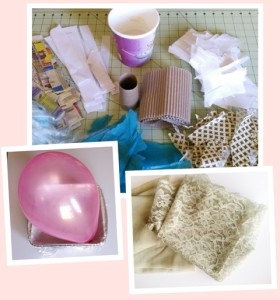
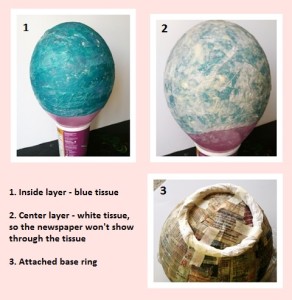
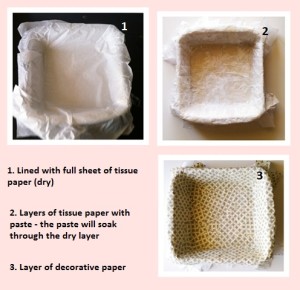
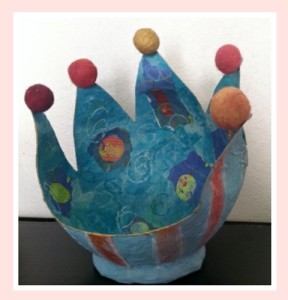
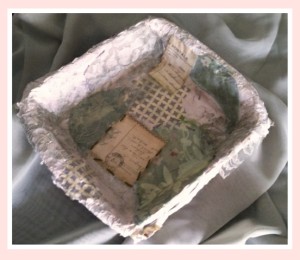



Recent Comments